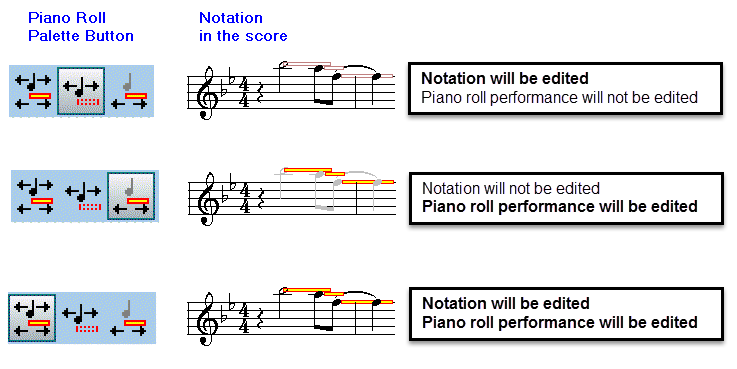|
<< Click to Display Table of Contents >> Understanding Piano Roll Notation |
  
|
|
<< Click to Display Table of Contents >> Understanding Piano Roll Notation |
  
|
One of the main ways you can give "feeling" to the performance of notes, that you have previously entered with the mouse and keyboard, is to adjust the exact as-performed timing of the notes. That is, you can adjust the as-performed attack and release times of the notes.
Composer's Piano Roll Notation helps you visualize the as-performed timing of notes:

The rectangles drawn on top of the notes show the actual performed timing of the notes. These rectangles are called "Piano Roll Notation" because they resemble the hole cutouts for notes in piano rolls of mechanical player pianos that were popular in the late 1800's and early 1900's. The left and right edges of the rectangles indicate the as-performed timing of the notes. Because normal spacing of notes in a score is not exactly proportional to actual note durations, the lengths of the rectangles are not totally precise. Nevertheless, the rectangles serve to clearly show you where notes start and stop.
Defining a few terms associated with the Piano Roll feature.
All these terms can refer to the notated (as-notated) or performed (as-heard) aspect of the note, and which can be edited separately in Composer:
•Attack - the beginning of a note
•Duration - the length of time a note sounds
•Release - the end of a note
•"As performed" - what you actually hear when playing the song file in Composer
•"As notated" - what you see as the sheet music displayed in Composer
The color of rectangles may be yellow (below) instead of white (above):

If the piano roll rectangle is white then the performance will not be edited. If it is yellow it will be edited.
If the color of the notation is gray then the notation will not be edited. If it is black then it will be edited.

There is some variation in the "as performed" durations and attacks of notes that give "life" to a performance. Composer's transcription of .mid or .kar files is optimized to give you an easy-to-read score while keeping the "life" in the performance. Conversely, if you have a very "robotic" file, you can use Composer's Piano Roll tools to create a more humanized performance of the song.